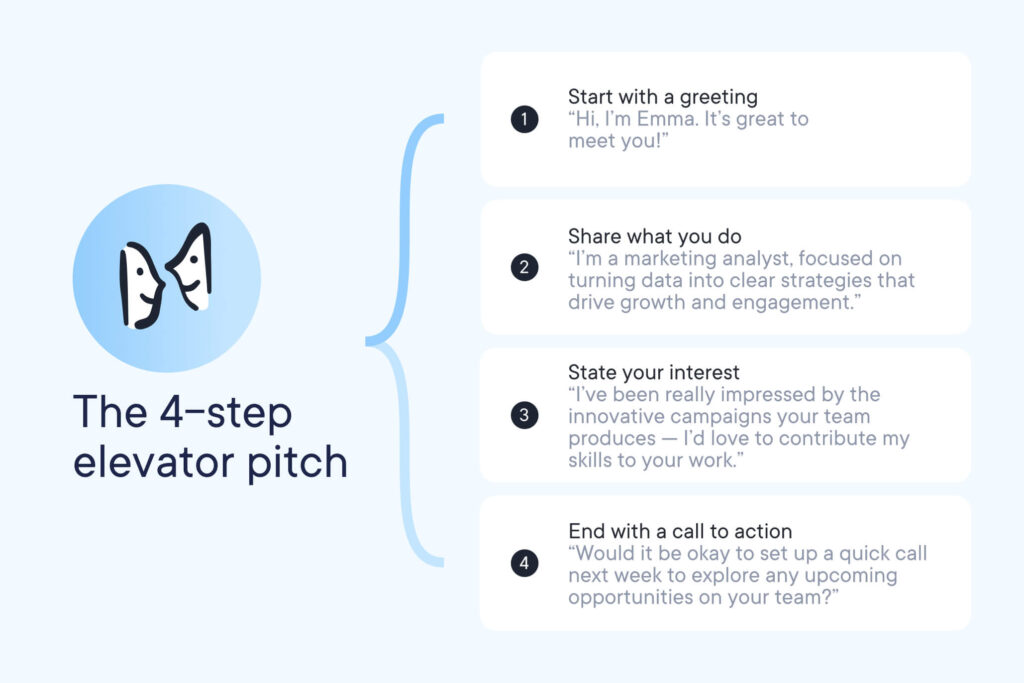
Compare Providers
Download our outplacement comparison sheet
Request Pricing
Compare our rates to other providers
If you were caught in an elevator with your interviewer, could you communicate why you should work for their company in under 30 seconds? This moment of pressure and opportunity is exactly what an elevator pitch is designed for. So it’s important to know how to write an elevator pitch that’s professional and compelling.
Whether you’re at a networking event, chatting over coffee, or actually riding in an elevator with a potential employer, being able to quickly and clearly express who you are, what you do, and why it matters to them is an essential part of your professional toolkit.
In this article, we’ll walk you through how to write an elevator pitch, tailor it for specific roles, and avoid the common pitfalls that can trip people up.
What Is an Elevator Pitch?
An elevator pitch (also known as an elevator speech, personal pitch, professional pitch, or networking pitch) is a brief, persuasive summary of your experience and value. It’s called an elevator pitch because it should be short enough to deliver during a quick elevator ride, roughly 30 seconds or less.
Your elevator pitch is your chance to answer the question: Why should someone hire you, refer you, or remember you?

Why Does Your Elevator Pitch Matter?
Every company has a value proposition, a way of communicating the benefit that they offer to customers or clients. Similarly, your elevator pitch should express the value that you offer as a candidate.
When a company hires you, they’re making an investment. They’re paying you (the cost) in exchange for the skills, knowledge, and experience that you bring (the value).
So you need to know how to write an elevator pitch that demonstrates how you will:
- Solve a problem.
- Create value.
- Meet a specific need.
In short, your elevator pitch is your personal value proposition.
If you’re looking for ways to support your organization’s employees in developing and communicating their individual value, click below to learn more about our Careerminds leadership and career coaching services.
How Do You Write a Good Elevator Pitch?
Crafting a compelling elevator pitch takes preparation and clarity. Here’s a straightforward, step-by-step approach to writing one that stands out:
1. Start with Research
Before writing your elevator pitch, get clear on the opportunity at hand:
- What are the company culture and values?
- What is required for the role?
- What kind of person succeeds there?
This will help you tailor your pitch statement and speak directly to what the employer or networking contact cares about.
2. Define Your Core Message
Use these guiding questions to identify your unique value proposition:
- What skills, traits, or achievements set me apart?
- What problems am I especially good at solving?
- What results or outcomes have I produced in past roles?
3. Structure Your Pitch
Here’s a simple formula to follow as you outline and write your elevator pitch:
- Introduction: Who are you, and what do you do?
- Value: What is your most unique strength or recent achievement?
- Goal: What are you looking for, and how can you help the company?
COPYABLE EXAMPLE:
Hi, I’m Jordan, a marketing strategist with a track record of increasing brand engagement through data-driven campaigns. At my last company, I led a team that grew web traffic by 60 percent in one year. I’m passionate about helping companies grow their digital presence and I’d love to bring that energy to your team.
4. Tailor It for Every Role
Just as you should tailor your resume and cover letter, you should know how to write an elevator pitch that is slightly different for each opportunity. Once you get the hang of writing one elevator speech, tweaking it to suit different jobs becomes much easier.
5. Practice Your Pitch
Once you’ve written your tailored elevator pitch, practice it out loud. Rehearse it in front of a mirror, with a friend, or even record yourself to review your delivery and make adjustments. The goal is to sound confident, conversational, and natural.
Need a place to start? Try this basic template:
COPYABLE EXAMPLE:
Hi, I’m [Your Name], a [your profession or specialty] with [X years] of experience in [industry/skill]. I have [describe your key achievement or result], and I’m passionate about [your value or goal].
What Are the Key Components of an Elevator Pitch?
The most effective professional pitches share a few essential traits. Make sure that your elevator pitch is:
- Brief: 30 seconds or less in length.
- Clear: No jargon or rambling.
- Tailored: Specific to the job and/or audience.
- Value-driven: Focused on what you bring to the table.
- Confidently delivered: Practice helps!
Common Questions About Elevator Pitches
1. What Are the Key Components of an Elevator Pitch?
A great elevator pitch includes your name, what you do, a relevant result that you recently achieved, the unique value you can offer, and a statement of interest or career goal.
2. How Do You Write a Good Elevator Pitch?
Start with your unique value proposition. Structure it into a brief but compelling story that includes who you are, what you’ve done, what you want to do next, and how that relates to the specific opportunity.
3. Can You Provide Examples of Effective Elevator Pitches?
Here are a few variations of personal pitches based on different industries and experience levels:
COPYABLE EXAMPLE:
For a marketing role
Hi, I’m Sam, a content marketer with a passion for brand storytelling. I recently led a campaign that boosted lead generation by 40 percent%. I’m looking to bring that same creativity and data focus to a fast-growing tech company.
COPYABLE EXAMPLE:
For a tech support role
I’m Alex, an IT support specialist with five years of experience resolving software issues and training end users. I pride myself on making tech less intimidating, and I’d love to help your team stay productive and connected.
COPYABLE EXAMPLE:
For a recent graduate
I’m Priya, a recent business grad with internship experience in HR and talent development. I created a new onboarding checklist that cut new hire ramp-up time by 25 percent%, and I’m excited to keep improving employee experience wherever I go.
How to Write an Elevator Pitch: Key Takeaways
Crafting a standout elevator pitch isn’t just about reciting your resume; it’s about owning your story, communicating your unique value, and making a strong impression in less time than it takes to ride an elevator. A strong elevator speech can open doors and spark opportunities that you didn’t see coming.
With practice and intention, your elevator pitch can become a powerful reflection of your strengths, your vision, and your next career move.
Here are the key takeaways:
- An elevator pitch is your personal value proposition. It should highlight who you are, what you do, and how you create impact in 30 seconds or less.
- Research is essential. Tailor your pitch based on the role, company, or industry you’re targeting.
- Follow a simple structure. Start with an introduction, share a key value or achievement, and end with your goal or interest.
- Practice makes perfect. Rehearse your pitch until it feels natural and confident, not scripted.
- Keep it brief and jargon-free. Your pitch should be clear, compelling, and easy to understand.
- Always adapt. Customize your pitch for different opportunities to make the strongest connection.
At Careerminds, we specialize in helping professionals confidently communicate their value through personalized career and leadership coaching. Whether you’re supporting employees through a transition or developing future leaders, we’re here to help. Click below to speak with our experts and discover how we can partner with your organization.
In need of outplacement assistance?
At Careerminds, we care about people first. That’s why we offer personalized talent management solutions for every level at lower costs, globally.



